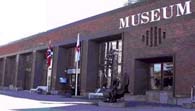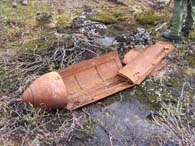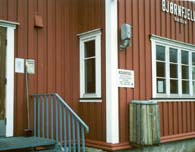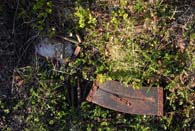Battle Of Narvik Self-Guided Tour

Editor in Chief’s Note: The March 2011 issue of Armchair General magazine features the Battle Studies article, “Dietl, Hero of Narvik,” by Lars Gyllenhaal. German General Eduard Dietl became a national hero in 1940 when he defeated the British-led Allied incursion into German-occupied Norway. As a Web Extra complementing Gyllenhaal’s outstanding article, we present this Self Guided Tour of the Narvik area that the author has created.
In France you’ll find plenty of museums devoted to World War II, but little in the way of battlefields still “littered” with military equipment. You may have heard that such places exist in Russia. They do. But Armchair General suggests an easier way to see World War II paraphernalia still in situ: Narvik in Norway, where General Eduard Dietl became a German superhero.
{default}THE TOUR
Narvik offers World War II sights and experiences well worth the travel and lodging expenses. Still, it would be a shame to come all the way to Narvik and not visit Lofoten or some other adjacent area of historical significance. So, to get to know more about the whole region, the Barents Euro-Arctic Region (Barents Region), I recommend first exploring the following non-profit websites: barentsroad.org and barentsinfo.org. Before you actually visit Narvik make sure you visit narvikinfo.no to find out about accommodation, tour operators, car rentals and “civilian” sights.
In Narvik there are several ways to stay: from fine hotels to youth hostels and private apartments. As for me I stay at “Spor 1” the simple but friendly youth hostel closest to the main town square (even though I am possibly no longer considered to be a “youth”). You will find a presentation of “Spor 1” and most other places at the above mentioned Narvik website.
This suggested Narvik tour is best done in June to August. Even during these months there may be rain and even snowfall up in the mountains, but the summer weather generally speaking won’t stop most plans. The tour can also be done in late May and September, even in early October – but with a high probability that the weather will affect your plans negatively. Always – even for a trip in July – make sure to bring along rain- and windproof garments. The tour requires at least two full days but can easily be stretched to one week or even two if you want to hike the actual battlefields.
TOUR POINT 1 – NARVIK WAR MUSEUM
 Logically, the first point of your first visit to Narvik should be the Narvik War Museum (warmuseum.no). Here you will learn about nearly all aspects of the struggle for Narvik, and you can buy books, etc. Although most books are in Norwegian you will find some useful tactical maps in some of them, especially Fjellkrigen by Berg & Vollan. If you plan to do the advanced tour, involving two days of pretty tough hiking, you should buy the following two maps in one of the book shops in Narvik (e.g. the one in the mall across the museum): maps no. 1431 I and 1432 II in the series by Statens kartverk (if you enter Norway from Sweden you could instead buy a single Swedish map, the BD6 covering Abisko-Narvik). There are both Norwegian and Swedish firms that arrange dives on the many World War II wrecks by Narvik. In Narvik harbor seven wrecks are allowed to dive on, all within 5-10 min by powerboat. Just remember that the water temperature is never pleasant. For wreckdiving info and contacts see the above website. Using the main road, the E6, and exiting the city towards Sweden (the east) you will see the French monument on your left hand side, by the fjord. But to see things in a somewhat chronological order I suggest you save it till your return (when it’ll be on your right hand side, easing access).
Logically, the first point of your first visit to Narvik should be the Narvik War Museum (warmuseum.no). Here you will learn about nearly all aspects of the struggle for Narvik, and you can buy books, etc. Although most books are in Norwegian you will find some useful tactical maps in some of them, especially Fjellkrigen by Berg & Vollan. If you plan to do the advanced tour, involving two days of pretty tough hiking, you should buy the following two maps in one of the book shops in Narvik (e.g. the one in the mall across the museum): maps no. 1431 I and 1432 II in the series by Statens kartverk (if you enter Norway from Sweden you could instead buy a single Swedish map, the BD6 covering Abisko-Narvik). There are both Norwegian and Swedish firms that arrange dives on the many World War II wrecks by Narvik. In Narvik harbor seven wrecks are allowed to dive on, all within 5-10 min by powerboat. Just remember that the water temperature is never pleasant. For wreckdiving info and contacts see the above website. Using the main road, the E6, and exiting the city towards Sweden (the east) you will see the French monument on your left hand side, by the fjord. But to see things in a somewhat chronological order I suggest you save it till your return (when it’ll be on your right hand side, easing access).
TOUR POINT 2 – GERMAN DESTROYER
 I had seen the rusty hulk of the German destroyer Georg Thiele in books but seeing it in real life is different. When first seeing it from the parking lot it seems to be rather small. Well, it is not small and really something to see up close: hatches open, dangling chains and hearing the eerie sounds from the wind, or the waves? On the minus side there is no marked path to it and usually the paths are slippery. But you can also see the ship up close by taking a boat cruise of the fjords, via the tourist office. Please also note that there is no guarantee that the wreck will still be above surface when you get to Narvik. A great deal of the Georg Thiele has been above the waterline for 65 years now. But lately the wreck has been moving through the forces of nature and time. So, no guarantees except that if it’s still there, there’s no entrance fee and no opening hours either! To get to Georg Thiele from Narvik city: before you reach the bridge over the Rombaken fjord, take the last right-hand road and drive all the way to the end, where you’ll find a power station. Look beyond the station, some kilometers, and… ! With a good camera or binoculars you don’t have to get closer. Getting closer by foot requires being fit plus good hiking shoes (boots).
I had seen the rusty hulk of the German destroyer Georg Thiele in books but seeing it in real life is different. When first seeing it from the parking lot it seems to be rather small. Well, it is not small and really something to see up close: hatches open, dangling chains and hearing the eerie sounds from the wind, or the waves? On the minus side there is no marked path to it and usually the paths are slippery. But you can also see the ship up close by taking a boat cruise of the fjords, via the tourist office. Please also note that there is no guarantee that the wreck will still be above surface when you get to Narvik. A great deal of the Georg Thiele has been above the waterline for 65 years now. But lately the wreck has been moving through the forces of nature and time. So, no guarantees except that if it’s still there, there’s no entrance fee and no opening hours either! To get to Georg Thiele from Narvik city: before you reach the bridge over the Rombaken fjord, take the last right-hand road and drive all the way to the end, where you’ll find a power station. Look beyond the station, some kilometers, and… ! With a good camera or binoculars you don’t have to get closer. Getting closer by foot requires being fit plus good hiking shoes (boots).
TOUR POINT 3 – GUN POSITIONS AND DZ
 Get back on the E6, cross the bridge and continue north until you reach the E10 leading to Bjoernfjell and Sweden. Take the E10 and drive until you cross the bridge over oevre Jernvatnet. You should notice at least one sign proclaiming “krigsminne”, meaning war memorial. Here you’ll find several large German gun positions around the rocky height by the parking place. In their midst is a metal plaque commemorating 168 Yugoslavs who were shot on this spot in 1942. These men were from a group of 600 Yugoslav slave-workers, of whom only 80 survived the war. Their task was to construct the road to Sweden, as the Germans feared that the railway would be sabotaged. This did not occur however, so this German project was of no use during the war. Below the gun positions, by the lake, there are some private houses. If you ask kindly the owners may show you were to look in the area for remains from 1940. Otherwise you may also simply walk south of the gun position. It’s a drop zone. If you are prepared to spend a couple of hours here chances are that you will stumble upon some make-shift positions from 1940. In 2004 there was at least one German parachute container in this area, by a small lake known as “container lake”. Although empty and broken it’s pretty cool to see. You may even find a parachute harness lying on a rock. The area is more rock surface than anything else and so many manufactured items left behind will be recognizable for years to come. Still, it must be emphasized that you may find absolutely nothing at all here. The trick is to be fit, have plenty of time and have/develop a sense of where positions are useful. The rule regarding World War II items found in Norway is simple: feel free to photograph them, but don’t remove anything as 1. It could be dangerous unless you’re an unexploded ordnance specialist. 2. It’s illegal to take home relics found in the open – because they legally belong to the Norway. 3. It’s very satisfying to discover history in situ – it’s a growing hobby. So, let others enjoy as well. Besides, that rust will never look as good on a shelf. Without the context it just isn’t very exciting. Land mines? In the Narvik area no land mines should remain. Still, all battlefield hiking is done completely at your own risk!
Get back on the E6, cross the bridge and continue north until you reach the E10 leading to Bjoernfjell and Sweden. Take the E10 and drive until you cross the bridge over oevre Jernvatnet. You should notice at least one sign proclaiming “krigsminne”, meaning war memorial. Here you’ll find several large German gun positions around the rocky height by the parking place. In their midst is a metal plaque commemorating 168 Yugoslavs who were shot on this spot in 1942. These men were from a group of 600 Yugoslav slave-workers, of whom only 80 survived the war. Their task was to construct the road to Sweden, as the Germans feared that the railway would be sabotaged. This did not occur however, so this German project was of no use during the war. Below the gun positions, by the lake, there are some private houses. If you ask kindly the owners may show you were to look in the area for remains from 1940. Otherwise you may also simply walk south of the gun position. It’s a drop zone. If you are prepared to spend a couple of hours here chances are that you will stumble upon some make-shift positions from 1940. In 2004 there was at least one German parachute container in this area, by a small lake known as “container lake”. Although empty and broken it’s pretty cool to see. You may even find a parachute harness lying on a rock. The area is more rock surface than anything else and so many manufactured items left behind will be recognizable for years to come. Still, it must be emphasized that you may find absolutely nothing at all here. The trick is to be fit, have plenty of time and have/develop a sense of where positions are useful. The rule regarding World War II items found in Norway is simple: feel free to photograph them, but don’t remove anything as 1. It could be dangerous unless you’re an unexploded ordnance specialist. 2. It’s illegal to take home relics found in the open – because they legally belong to the Norway. 3. It’s very satisfying to discover history in situ – it’s a growing hobby. So, let others enjoy as well. Besides, that rust will never look as good on a shelf. Without the context it just isn’t very exciting. Land mines? In the Narvik area no land mines should remain. Still, all battlefield hiking is done completely at your own risk!
TOUR POINTS 4, 5 AND 6 – BJOERNFJELL
 The fourth point of the tour is Bjoernfjells railway station, virtually unchanged since it was used by the Fallschirmjägers. From here you may want to take a walk into Sweden. Just take the dirt road parallel with the rails to Sweden. On the border you will find several positions up on the minor heights facing Sweden. You may also find some minor remains from World War II. There are more places in and around the small village with remains like shell cases: cracks in the ground and around positions and house ruins. To continue to the fifth point go back to the railway station and cross the rails after having made sure there are no trains. Take the path that winds its way westwards parallel with the rails and you will reach the big railway memorial where drop containers were collected. Continue for some hundred meters along the path closest to the rails and you will eventually see the sixth point, the old English-style house that was the home and HQ of General Dietl during much of the fighting in 1940. Fifty meters before the house is a small sign about the history of the house. The house itself is private property but if you keep a reasonable distance you may walk around it and discover several defensive positions.
The fourth point of the tour is Bjoernfjells railway station, virtually unchanged since it was used by the Fallschirmjägers. From here you may want to take a walk into Sweden. Just take the dirt road parallel with the rails to Sweden. On the border you will find several positions up on the minor heights facing Sweden. You may also find some minor remains from World War II. There are more places in and around the small village with remains like shell cases: cracks in the ground and around positions and house ruins. To continue to the fifth point go back to the railway station and cross the rails after having made sure there are no trains. Take the path that winds its way westwards parallel with the rails and you will reach the big railway memorial where drop containers were collected. Continue for some hundred meters along the path closest to the rails and you will eventually see the sixth point, the old English-style house that was the home and HQ of General Dietl during much of the fighting in 1940. Fifty meters before the house is a small sign about the history of the house. The house itself is private property but if you keep a reasonable distance you may walk around it and discover several defensive positions.
TOUR POINTS 7 and 8 – FRENCH MONUMENT, WAR CEMETERY
Turning back to Narvik, this time stop at the large French memorial to your right just before entering the city. This is where the French Foreign Legion and Norwegians went ashore on the 28th of May 1940, taking back Narvik from Dietl. Continuing into the city, on your left hand side, you will see the local cemetery and war cemetery for both Germans and Allies. You have now completed the tour and may want to return to the War Museum as you will probably have some new questions.
ADVANCED TOUR POINTS
 If you are fit, love hiking, are used to reading maps and have brought along a tent, you will want to visit the site of the final fighting in 1940, around Holmvann (a.k.a. Holmvatnan and Holmvatnet), 8 kilometers (as the crow flies) north of Bjoernfjell. You will then definitely need those maps mentioned initially. It is NOT a good idea to walk from Bjoernfjell village. Instead, park your vehicle by the north end of Lake Langvann (“Langv.”) some 5 kilometers northwest of Bjoernfjell. Here a path starts that will take you around Rundfjellet and into the area of the final fighting. The heights “620” and “698” are among the best in the region for finding traces of World War II. Just bear in mind that this hike is very demanding as it is steep and the path is only occasionally marked, by piles of stones. The Norwegian outdoors philosophy is not to disturb the landscape with signposts. But this means that you MUST be able to use a compass and a map to venture into the Norwegian mountains. Theoretically, it should be possible to do Holmvann in a day, not sleeping there, but in practice it is necessary – to be able to make those discoveries. It is helpful, but not vital, to bring along the book Fjellkrigen, to find the major positions. Finally, for those of you who are warbird buffs: World War II aircraft wrecks are still discovered once in a while in the Narvik area. Ask around. But there is a more easily accessible one by Porjus in Sweden (300 km from the border), a Lancaster bomber that you can read about at barentsroad.org
If you are fit, love hiking, are used to reading maps and have brought along a tent, you will want to visit the site of the final fighting in 1940, around Holmvann (a.k.a. Holmvatnan and Holmvatnet), 8 kilometers (as the crow flies) north of Bjoernfjell. You will then definitely need those maps mentioned initially. It is NOT a good idea to walk from Bjoernfjell village. Instead, park your vehicle by the north end of Lake Langvann (“Langv.”) some 5 kilometers northwest of Bjoernfjell. Here a path starts that will take you around Rundfjellet and into the area of the final fighting. The heights “620” and “698” are among the best in the region for finding traces of World War II. Just bear in mind that this hike is very demanding as it is steep and the path is only occasionally marked, by piles of stones. The Norwegian outdoors philosophy is not to disturb the landscape with signposts. But this means that you MUST be able to use a compass and a map to venture into the Norwegian mountains. Theoretically, it should be possible to do Holmvann in a day, not sleeping there, but in practice it is necessary – to be able to make those discoveries. It is helpful, but not vital, to bring along the book Fjellkrigen, to find the major positions. Finally, for those of you who are warbird buffs: World War II aircraft wrecks are still discovered once in a while in the Narvik area. Ask around. But there is a more easily accessible one by Porjus in Sweden (300 km from the border), a Lancaster bomber that you can read about at barentsroad.org
Lars Gyllenhaal was made a lifetime member of the Swedish Military History Commission in 2005. His latest book, Swedes at War: Willing Warriors of a Neutral Nation, 1914-1945 (with Lennart Westberg), was published by Aberjona Press (aberjonapress.com) in 2010. He has also done research for prize-winning documentary films, and was an editor of the book Victims, Victors: From Nazi Occupation to the Conquest of Germany as Seen by a Red Army Soldier by Roman Kravchenko-Berezhnoy (aberjonapress.com).


What is going on with the newspaper “News Of The World†phone-hacking scandal in the UK? The causality’s are starting to grow: News of The World itself closed down. Rebekah Brook (News International chief executive) arrested on suspicion of corruption and phone hacking. The UK’s most senior policeman John Yates resigned. The News Of The World reporter who blew the whistle on phone hacking at the paper has been found dead, which is now being treated as “unexplained”. Rupert and James Murdoch are to appear before government committee to answer questions on the phone hacking scandal. The news is making the news; whatever next?
I was in Narvik in 2014, I was told about some German bunkers up next to the hospital. I went up there, and bulldozers were clearing away scrub that had grown over them. They look out over the harbour with panoramic views. I could not go in due to the activity, and I was leaving later that day. Also some trench lines on a ridge line in the area up behind houses were still visible. There are probably more bunkers too, everywhere the Germans went they built them.